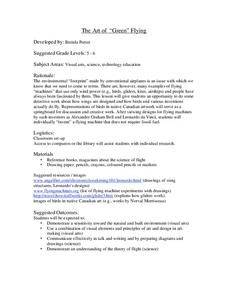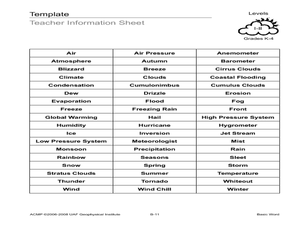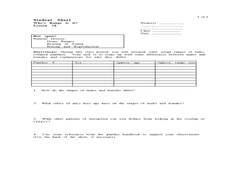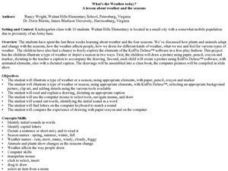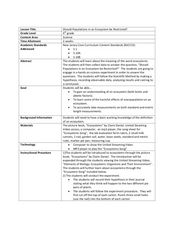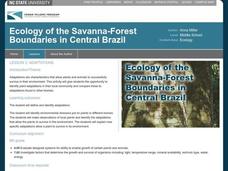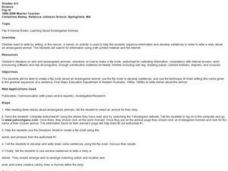Curated OER
Habitat Art: Florida Panthers
Students discover the lifestyles of a Florida Panther by investigating its habitat. In this wild animal lesson, students utilize the Internet to research the habits of a Panther and what their habitat is. Students create an...
Curated OER
Performance Art and The Waste Stream
Students research local waste management services, discuss findings, give opinions about what they have found, offer solutions and ideas, and create performance art, design art works, and fine art works to convey information on waste...
Curated OER
The Art of "Green" Flying
Students create an airship that doesn't use fossil fuel. For this flying lesson, students research different types of flying machines that only use wind power. They discuss invention designs by Alexander Graham Bell and Leonardo Da Vinci...
Curated OER
Looking at French Decorative Arts: The Science of Good Design
Young scholars examine the style of an 18th-century compound microscope and its case. In this scientific design lesson plan, students look at Jacques Caffieri's, "Compound Microscope and Case" before comparing the design to a modern...
Science 4 Inquiry
Eukaryotic Cells: The Factories of Life
Eukaryotes include humans, animals, and plants. Scholars learn about the parts of eukaryotic cells. They design models of a store and match the correct function of each part to the function of a part of the cell. They review their...
Curated OER
Basic Word
Students create a poster of a weather-related word. In this weather lesson, students randomly choose a weather word, define it, and draw a picture of it. They also use Word Art to create the title of their poster.
Curated OER
Tread Lightly: Visualizing Footprints
The student reflects on concepts of ecological footprints and climate changes. In this Art lesson, students will produce a visual representation showing understanding of how ecology and climate affects the world.
Curated OER
Spring Time Trees/Flowers
Plan ahead! Integrate science and language arts! Schedule your reading of C.S. Lewis’ The Lion, the Witch, and The Wardrobe to coincide with the arrival of spring. As pupils read Chapter 11 of the Lewis classic, they are assigned one of...
Curated OER
Who's Range is it?
Students investigate the habits of panthers by analyzing radio transmitted data. In this animal life lesson plan, students utilize computers to view the range of different statistics dealing with Florida panthers. Students...
Curated OER
Recycled Paper
Sixth graders keep track of the amount of paper they consume on a daily, weekly, and monthly basis. The goal of the lesson is to have them all find ways to reduce the amount they use. Everyone creates recycled paper from old newspapers...
Curated OER
Honing in on Hummingbirds
Students explore ruby-throated hummingbirds. In this cross-curricular hummingbirds lesson, students listen to the book The Mystery of the Missing Hummingbirds and choose related topics to research with a partner. Students draw or...
Curated OER
Clay Sculpture: Relationships
Students explore art history by conducting an in-class activity. In this sculpting lesson, students examine previously created art sculptures in a textbook. Students utilize clay, sculpting tools and grey paper to create their own...
Curated OER
Weather And The Seasons
Students illustrate characteristics of the different seasons using digital and pen and paper drawings. They creat captions for their drawings and present them to the class. Students compare and contrast their pen and paper drawing...
Curated OER
Art in the Sky
First graders become familiar with four types of clouds by experimenting with cameras and exploring the web. They observe illustrators' renderings of clouds and draw their own representation of clouds.
Curated OER
The Water Cycle
Second graders use the program HyperStudio to draw and describe the water cycle. In this science and technology lesson plan, 2nd graders will first become familiar with the water cycle by exploring books and websites in the classroom....
Curated OER
Should Populations in an Ecosystem be Restricted?
Fourth graders experiment to determine how overpopulation effects ecosystems specifically plants. In this ecosystem lesson, 4th graders conduct an ecosystems experiment after listening to Claire Daniel's, Ecosystems. They watch a video,...
Curated OER
Global Warming Statistics
Students research real-time and historic temperature data of U.S. and world locations, and analyze the data using mean, median, and mode averages. They graph the data and draw conclusions by analyzing the data. A spreadsheet is used to...
Curated OER
Meet the Corals
Young scholars investigate the types of coral. In this oceanography lesson, students access the Fisheye View Cam Website and create their own coral garden by using various art supplies.
Curated OER
Adaptations
Sixth graders identify plant adaptations. In this adaptations lesson, 6th graders use digital cameras to photograph plants found on their campus. Students describe the adaptations for each plant.
Curated OER
How Do You Know A Panther Was Here?
Students research the signs that panthers leave. In this panther track instructional activity, students conduct Internet research into the signs that panthers leave such as tracks, scat, scrapes, and scratches. They make a...
Curated OER
Photosynthesis and Cell Respiration
Fifth graders participate in scientific inquires regarding the concepts of photosynthesis and cell respiration. For this photosynthesis and cell respiration lesson, 5th graders describe the process of photosynthesis with relation to...
Curated OER
The Delany Garden
Students design and create a garden. They select flowers in small groups and research them. They draw a diagram of the landscape for their garden and plant flowers and observe them as they grow.
Curated OER
Everybody Needs a Little Sunshine
Three activities introduce upper elementary ecologists to photosynthesis and food webs. In the first, an experiment is set up to determine how plants respond to different types of light. In the second, they connect organism cards with...
Curated OER
Flip It!
Students research an endangered animal using both printed material and the Internet. They organize their information and develop sentences to write a story to create a flip-it book. A worksheet is embedded in the activity for students' use.


